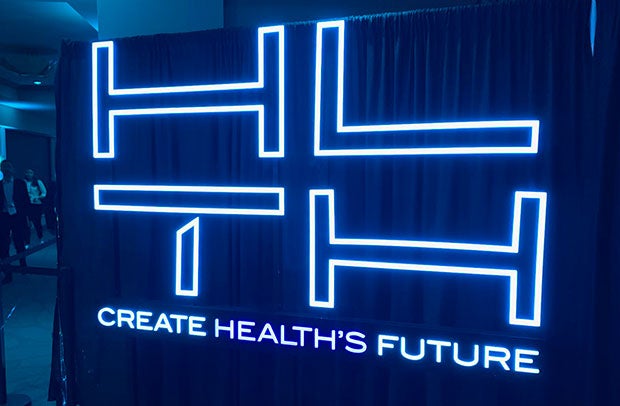

More Big Market Transformation Moves in Store Next Year

Last week, more than 6,000 people representing all sectors of health care gathered in Las Vegas for HLTH, a conference aimed at fostering cross-ecosystem collaborations to accelerate health care transformation.
Here are five health care predictions for the year ahead, based on what we at the AHA Center for Health Innovation took away from the event.
1. Employers will become even more active in seeking new solutions from nontraditional partners to manage employee health.
Self-insured employers increasingly are willing to contract directly with nontraditional care management providers, in part because they feel existing payer and provider care management programs fall short of delivering improved outcomes and reduced expense at scale. Employers at the event said they are seeing promising results from care management service providers like Livongo, which helps individuals manage diabetes and other chronic conditions, and Hinge Health, which helps manage knee, hip and other musculoskeletal pain to lessen the need for painkillers and surgery.
Employers are embracing broader uses of telemedicine as well, in urgent, primary and behavioral health care, including teletherapy. Ninety-six percent of large employers offer telemedicine services, and they often direct employees to specific platforms. This trend is one that should be watched closely by hospitals and health systems as more employers are partnering directly with telehealth players or directing patients to solutions offered by payers.
2. Care models will be hot; tech not, at least on its own.
Challenges surrounding typical chronic care management open the door for nontraditional solutions like those previously stated, but they also create a unique opportunity for traditional providers willing to disrupt their current practices. “We’ve managed chronic disease the same way for 20 years,” said Karen Murphy, R.N., executive vice president and chief innovation officer at Geisinger. To start, we treat patient conditions in silos, even though 40% have more than one chronic disease. Instead, we should look to design care management programs that recognize multiple disease states and treat patients holistically, she said.
Treating patients holistically means putting their preferences at the center of care models — a simple innovation in care delivery that is having profound results. One initiative that aims to spread age-friendly care models encourages providers to “systematically ask what matters to patients and embed that into the EHR to better inform individual care models,” said Jay Bhatt, D.O., senior vice president and chief medical officer of the AHA.
While new technologies like remote patient monitoring and artificial intelligence certainly have a role to play in these new care models, conference speakers suggested there’s more interest in figuring out the best care model for patients and providers first, and then finding technology that reduces friction for everyone.
3. New care models — and the ways in which technology is embedded within them — must remove barriers to health for all patients.
“We can no longer say that patients are being noncompliant. It’s our responsibility as health care providers to figure out how to remove barriers to improved health,” said Alisahah Cole, M.D., chief community impact officer, Atrium Health. In an attempt to reduce barriers to health, many providers are focusing more closely on the social determinants of health by launching new programs like fresh food “farmacies” or partnering with community organizations.
Ensuring equitable access to care is a challenge for the field when it comes to new treatments and technologies, as patients from diverse backgrounds often lag in clinical trial participation or utilization of new genetic treatments. “Often, these breakthrough treatments are available only for people near an academic medical center,” said Janice Nevin, M.D., president and CEO of ChristianaCare Health System. “We are committed to making sure these breakthrough technologies are accessible to everyone, in all communities.”
4. The number and type of new market entrants will continue to grow, and health care activity by nontraditional companies already in the market will expand.
In some cases, their activity will benefit providers. Serial entrepreneur Mark Cuban, a keynote speaker at the conference, said he’s launching a new drug venture that seeks to disrupt the high price of prescription drugs by selling them at cost plus 15%. First, he’s targeting to manufacture those that have had significant price hikes in the last few years, although he didn’t provide specific drug names. Another area of activity that received a lot of attention at the event: financial services support for patients. Mastercard is one of the companies looking to address patient pain points related to health care payment and financing. “Health care is at least a generation behind financial services [in this respect], and the inefficiencies in the consumer experience are absolutely horrific,” said Raja Rajamannar, the company’s chief marketing and communications officer.
5. We’ll all realize that high touch and high tech are not mutually exclusive.
And a blurring of what’s a technology vs. a service solution will follow. Some of the more recognized new market entrants that focus on care management, like Livongo and Babylon, not only utilize care models that rely heavily on technology, but also incorporate human care navigation when appropriate. Accordingly, it’s hard to categorize them exclusively as a technology company. In fact, Arvind Rajan, CEO of Cricket Health, which offers technology-enabled care management services for patients with chronic kidney disease, said, “We’re not a tech company, we’re a provider.”
Investors backing these solutions now almost expect these types of companies to have a services component. While companies need to be tech-enabled to be attractive investments, they can’t be just tech only. Instead, they need to find balance between the use of technology and the services overlaying technology to deliver the best patient outcomes.



